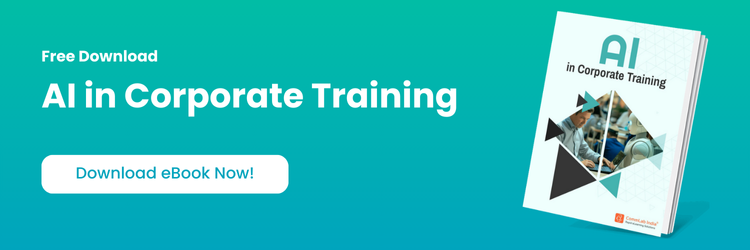We’ve all seen: AI is revolutionizing Learning and Development. And yes, it is. From personalized learning paths to automated content generation, the potential is massive. But here’s what often gets left out of the conversation — implementing AI in L&D isn’t all plug-and-play. It’s messy, complicated, and filled with real-world friction.
For L&D professionals, the excitement around AI often comes with a hard pause the moment it hits execution. Between compliance complexities, cultural pushbacks, and workforce readiness, AI adoption becomes less about what’s possible and more about what’s practical. Let’s talk about the real barriers.
Download Now: AI in Corporate Training
Table Of Content
AI in Learning and Development Is Here—But Are We Really Ready to Harness It?
Absolutely. But like any powerful tool, it comes with strings attached.
For learning and development, it can be both magical and messy. There’s no denying that AI is transforming how we train design, deliver, and scale for good reason:
- It personalizes learning paths in ways we could only dream of five years ago.
- It slashes development time with smart tools that generate content, voiceovers, even assessments.
- It allows us to finally make data-driven decisions — not gut calls — on what’s working.
And yes, it’s solving real business problems:
- Need to train a global team in a short span? AI translations and microlearning can make it happen.
- Want to reduce SME hours in development? AI Tools like Fireflies and ChatGPT cut prep time dramatically.
- How does AI boost engagement in learning? Adaptive learning platforms are giving us behavior-based nudges in real time.
But let’s be clear, implementation isn’t as easy as plugging in a new tool and watching the results roll in.
There’s complexity. There’s resistance. There are barriers most blog posts don’t talk about. That’s what I’ll unpack in the next part: the real-world challenges of bringing AI in learning and development from data privacy headaches to cultural mismatches and skill gaps no one wants to admit.
But for now, if you’re still on the fence about whether AI should be in your L&D toolkit, the answer is yes. Just be ready for what comes next.
1. Data Privacy Rules Can Slow You Down
One of the biggest showstoppers in AI implementation is data governance. AI thrives on data — learner behavior, performance stats, engagement patterns — but that raises serious compliance questions.
- In the EU, GDPR demands strict consent protocols, especially when using AI to track or enable personalized learning.
- Storing biometric data, like voice or facial recognition for assessments, becomes legally risky without watertight compliance.
- Even anonymized data can pose issues if re-identification is possible.
What is the Fix for Data Privacy Issues with AI?
L&D teams need legal counsel in the loop early, privacy-by-design practices, and clear communication with learners about data use.
2. Different Cultures, Different Learning Styles
AI-driven learning assumes a level of learner autonomy and technological comfort that’s not universal.
- In North America, there’s a bias toward self-paced, video-heavy, gamified content. AI fits right in.
Struggling to keep learners engaged? Let video do the talking—discover what video-based learning really is, why it works, and how to use it
- In parts of Europe or Asia, learning is more instructor-led, theory-based, or collective. AI can feel impersonal or even intrusive.
- Regions with stronger labor unions or regulatory scrutiny may push back on AI tools that track performance.

3. Not Enough Skilled People for AI Projects
AI promises smarter training, but building and managing AI-based systems requires a different kind of talent — and it’s in short supply.
- L&D professionals often lack technical know-how to evaluate AI tools or design data-informed learning experiences.
- IT teams may not have bandwidth to support L&D’s AI needs.
- Reskilling internal teams to be AI-ready is expensive and time-consuming — and ironically, that reskilling needs to be AI-powered too.
Forbes underscores that L&D teams using AI tools can quickly assess and bridge skill gaps, dynamically aligning workforce capabilities with evolving business needs.
What to do?
- Invest in foundational AI literacy across the L&D team.
- Bring in instructional designers with data science basics.
- Consider partnerships with AI-savvy vendors for a transitional phase.
4. Tech Infrastructure Isn’t Always Ready
Let’s be honest — not every organization’s LMS or IT ecosystem is ready for AI integration.
- Legacy LMSs don’t support real-time data processing or API connectivity needed for AI tools.
- Weak IT infrastructure in distributed or hybrid teams slows down AI tool performance.
- Compatibility between AI solutions and existing authoring tools or platforms is often an afterthought.
Quick Wins:
- Audit your current tech stack for AI compatibility.
- Start with modular AI tools (e.g., AI voiceovers, microlearning automation) that don’t require full system overhaul.
5. Trust and Transparency Issues
AI can feel like a black box. And when employees don’t understand how decisions are made (e.g., why they were assigned a particular learning path), they’re less likely to trust the process.
- Skepticism around bias and fairness can undermine adoption.
- Learners want to know: Who owns their data? Can AI replace their role?
- Managers often hesitate to use AI insights for performance-related conversations.

Final Thoughts: AI in L&D Needs More than Hype
AI isn’t just a new tool; it’s a mindset shift. And with that shift comes real, tangible challenges that deserve just as much airtime as the glowing success stories.
If you’re leading AI integration in L&D, don’t just chase the shiny new feature. Ground your strategy in legal clarity, cultural nuance, upskilled teams, and tech readiness. Only then can AI move from “trendy idea” to a transformative asset.
Want a head start?
Download our eBook which is packed with actionable insights for L&D leaders like you—from riding the AI wave with confidence, to building a future-proof workforce, and embedding AI into your design and development toolkit without the growing pains.
View the original article and our Inspiration here



